Spain
Granada – The Alhambra and Nasrid Palaces
Following their conquest of the Southern Iberian Peninsula in the 8th century, the Moors renamed the region Al-Andalus. In its heyday, their rule and influence extended to Southern France, parts of Italy, and Portugal. The Peninsula became a great Muslim civilization until 1492 when the Spanish Catholic kings conquered Granada.
The Alhambra, built by the Muslim sultans between 1238 and 1492, is a palatial “city” that sits on Sabika Hill overlooking Granada’s Old City. The Arabic name for Alhambra, “al-qal’a al-hamra,” translates to Red Fortress, which refers to the reddish hue of its strong exterior walls.
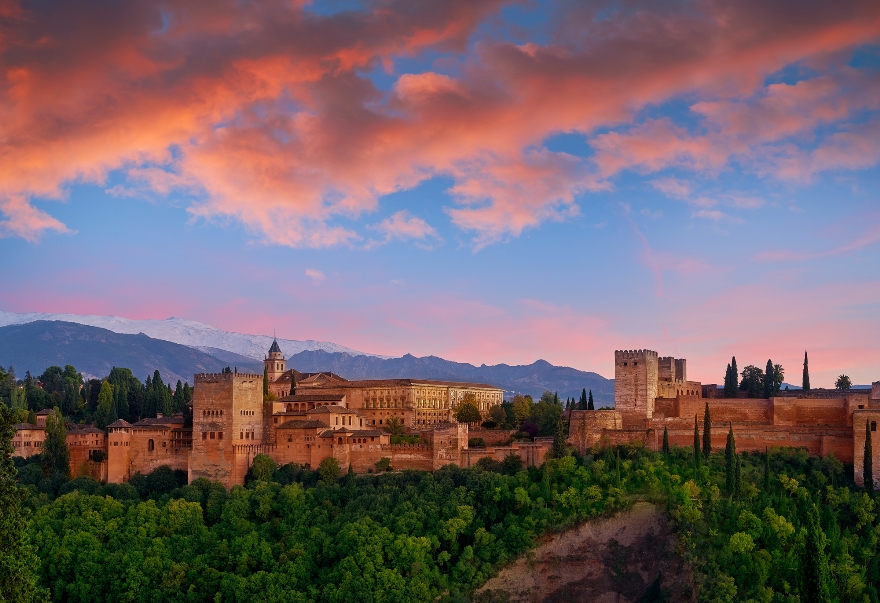
Within those intimidating walls lies a veritable architectural Wonder of the World that consists of the dazzling Nasrid Palaces, the Summer Palace on a hill overlooking the Alhambra, the Generalife Gardens, the Medina, and the Alcazaba. (The Summer Palace and Generalife Gardens are beyond the wall of the Alhambra.)
The oldest structure in the complex is the Alcazaba fortress. Unfortunately, all that remains of it today are the outer walls, towers, and ramparts. In 1238, the first Nasrid sultan, Mohammed I, made the Alcabaza his residence. While living within the walls of the fortress, he began establishing new royal palaces and the Nasrid city of Alhambra.
The Alhambra, as we see it today, is the result of the construction overseen by a succession of sultans of the Nasrid Dynasty. The grandeur, opulence, gardens, tranquil courtyards, and breathtaking interiors were built during the reign of Yusuf I and Mohammed V in the 14th century.
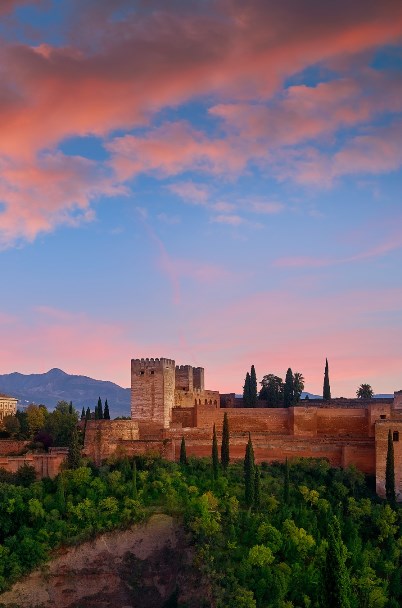
We began our exploration of the sprawling, ancient city on a hill, at the Summer Palace and the Generalife Gardens – the Architect’s gardens – outside the walls of the Alhambra. (Alarife means: architect). It’s a complex of blooming flowers, trees, fountains, water canals, fruit orchards, and vegetable gardens that surround the palace, which looks out at a panoramic view of the Alhambra and the Old City of Granada. Unfortunately, as lovely as the gardens are, they bear little resemblance to the original ones, which fell into disrepair and have since been reconstructed and replanted.
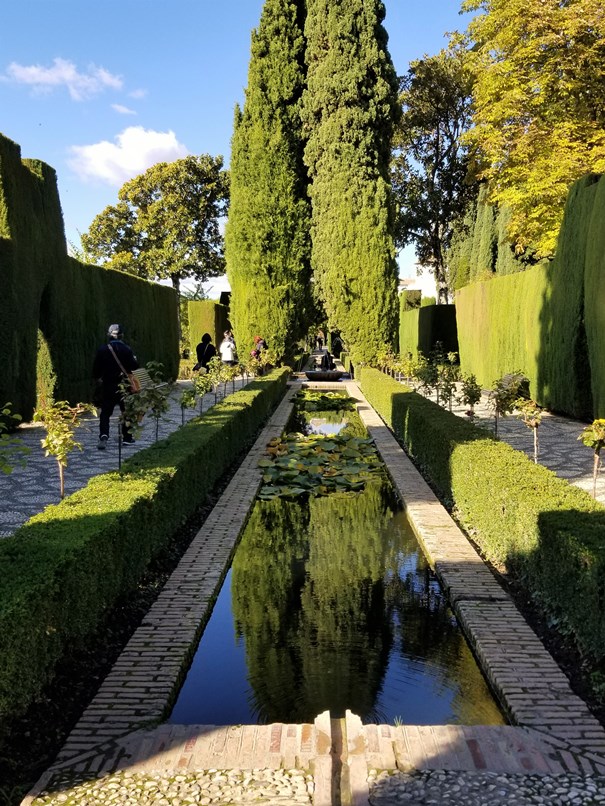
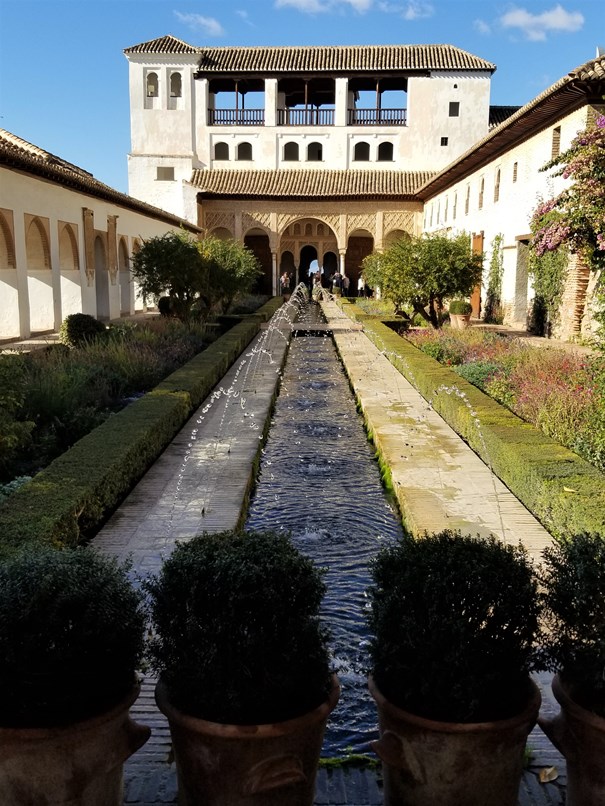
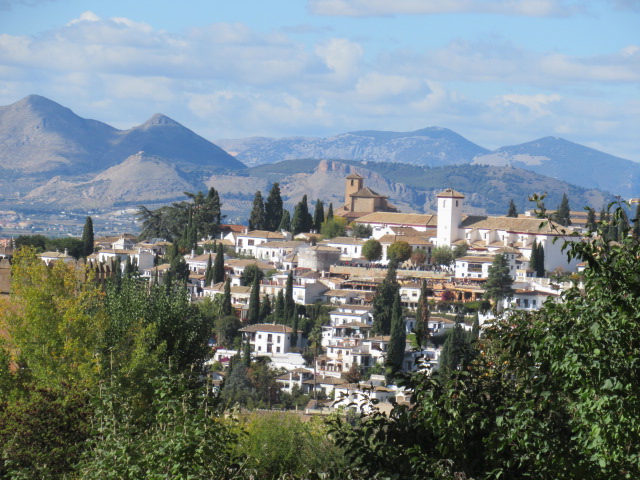
The Medina resembled a small, vibrant town that housed the staff who served the sultan and his family. There were shops, public baths, mosques, and residential quarters for civil servants, artisans, nobility, and shopkeepers. There is little remaining of the structures, but the ruins give one an idea of the layout and size of the Medina.
THE NASRID PALACES
There are three primary Nasrid Palaces.
Mexuar is the simplest of the palaces and has undergone significant restoration since the fall of the Nasrid Dynasty in 1492. It was used for judicial meetings and management of state affairs.
The Comares Palace was the primary residence of the sultans. It looks onto the Courtyard of the Myrtles, which is flanked by elaborately decorated meeting halls. The courtyard gets its name from the immaculately trimmed myrtles that line the edges of a tranquil reflecting pool, making the palace look as though it’s floating in space. The carefully conceived use of water in the form of fountains, reflecting pools, and water channels, is present throughout the Alhambra. It lends soothing tranquility to the courtyards and gardens. In the courtyard of the myrtles, one notices that the fountain pours gently into the pool without disturbing the smooth reflecting surface.
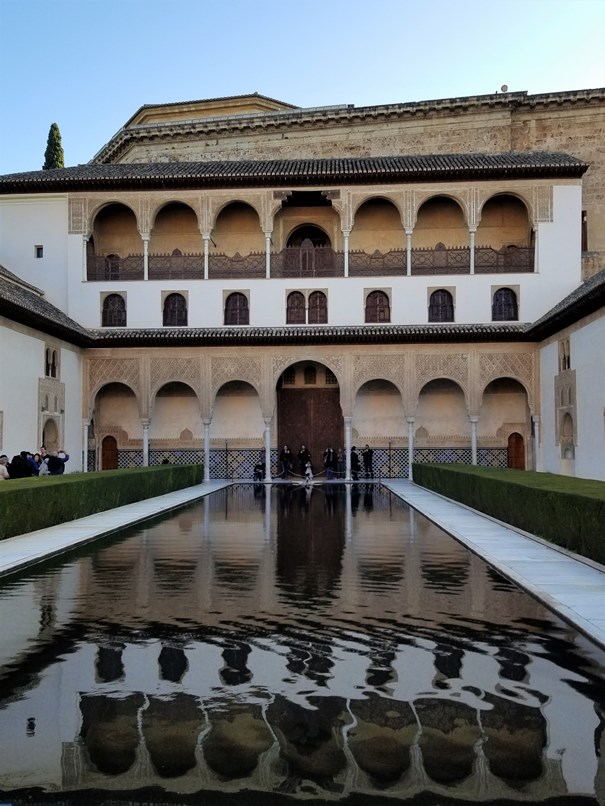
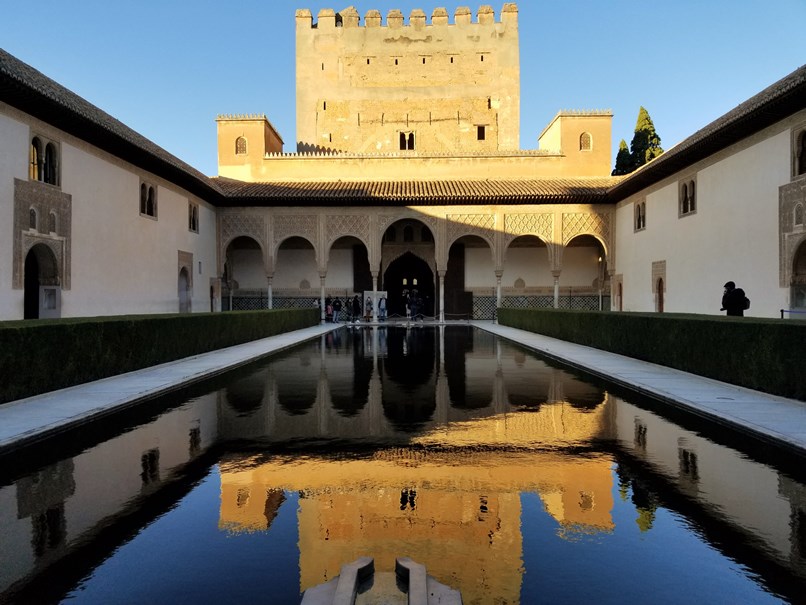
Within the walls of the Palacio de Comares is the Hall of the Ambassadors, where the throne was located, and the sultan held his important meetings and official receptions. The ceiling is covered in an interlaced pattern of carved cedarwood and the walls in decorative calligraphy inscriptions which contain texts from the Koran, poems, and prayers. The plasterwork is so delicate and intricate that it has the appearance of an elaborate fabric covering. Light filters in through arched windows where the glass is covered in a graceful lace-like pattern. The Nasrid masons were masters at experimenting with light and color in their plasterwork designs.
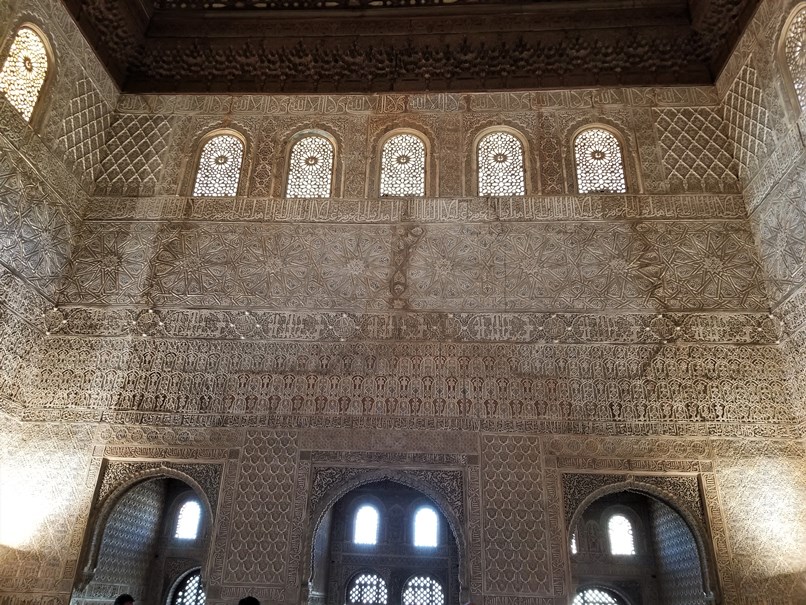
The Palace of the Lions – Palacio de los Leones was the sultan’s private palace for himself, his family, and his mistresses. Here, the most ornate and exquisite ornamentation of the Nasrid dynasty’s craftsmen and architects is on display. At the heart of the palace is the Courtyard of the Lions, where a circular fountain rests on the backs of twelve lions, which sprout water into four channels. The lions represent the twelve tribes of Israel, while the four water channels represent paradise.
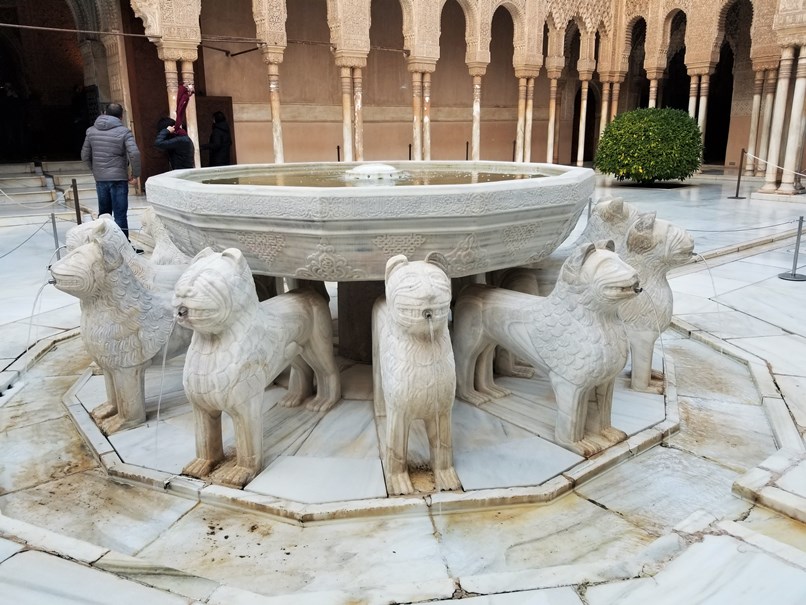
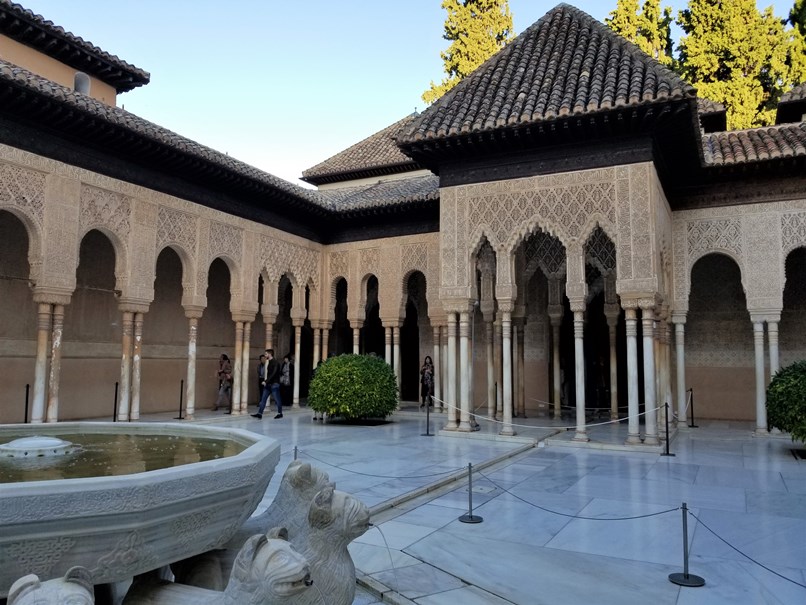
The courtyard is surrounded by a forest of slender columns topped by archways adorned in calligraphy and symbolic patterns.
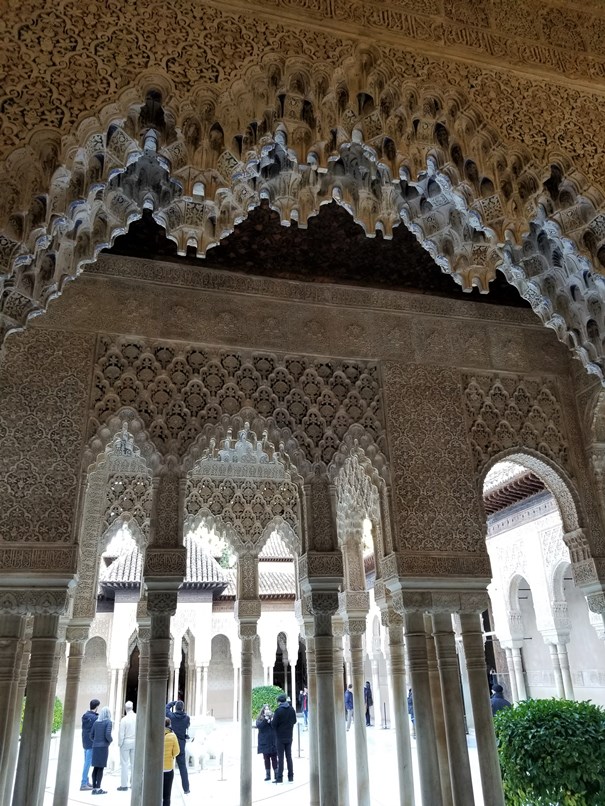
The Hall of Abencerrajes – located in the Palace of the Lions – has a spectacular 8-point star dome of “mocárabes.” Windows in the dome allow a soft stream of light to filter into the hall and give a magical glow to the ceiling. What are Mocárabes? The Moorish masons applied layer upon layer of plasterwork over one another, joined in different ways to create a stunning art form that resembles honeycomb, stalactites, and delicate cognac-colored underwater coral.
Ironically, rumor has it that it was in this magnificent hall that one of the sultans would have Abencerrajes knights beheaded. The Abencerrajes were a prominent family in Granada in the 15th century.
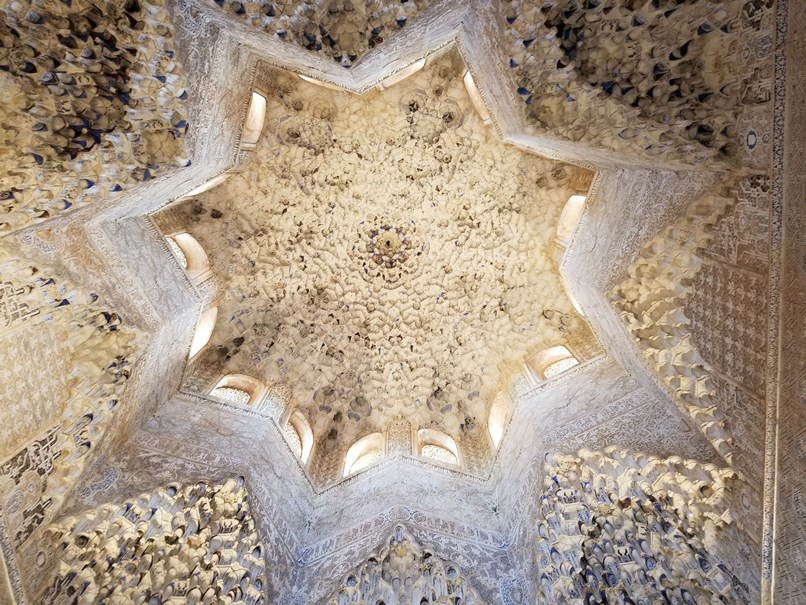
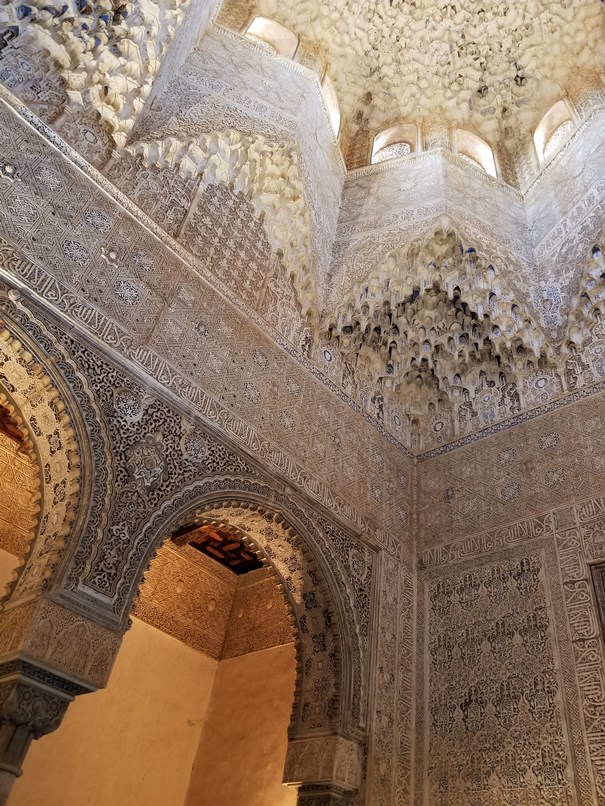
The Hall of the Two Sisters – Sala de Dos Hermanas. Here the ceiling reminds one of a massive flower made up of mocárabes that hangs above the hall. The hall gets its name from two large marble flagstones on the floor.
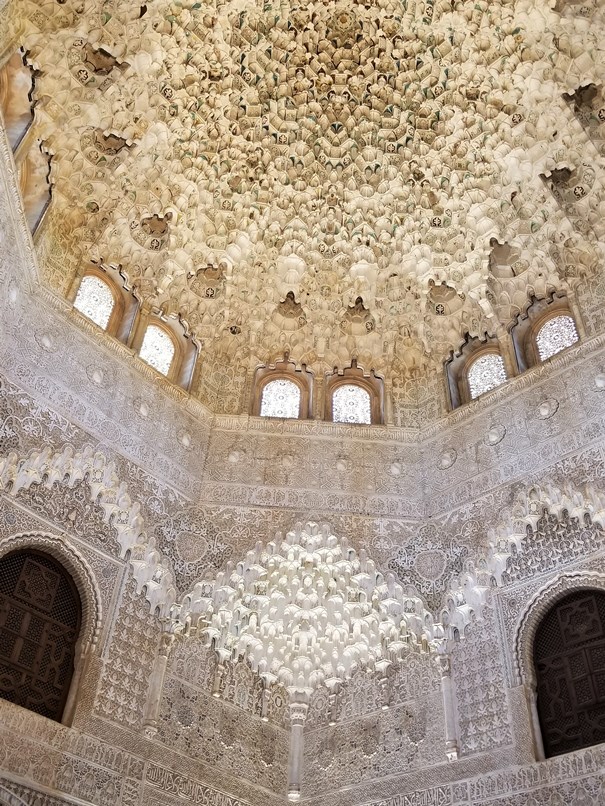
The Hall of the Kings, which can be accessed from the Courtyard of the Lions, is of particular interest because of the three paintings that adorn the ceiling. One depicts hunting scenes, another romantic scenes, and the middle and most important painting depicts the first ten sultans of the Nasrid Dynasty. Created during the reign of either Mohammed VII (1395-1410) or Yusuf III (1410-1424), it is assumed that these paintings are the work of Christian artists as the style highly resembles Christian art of that period.
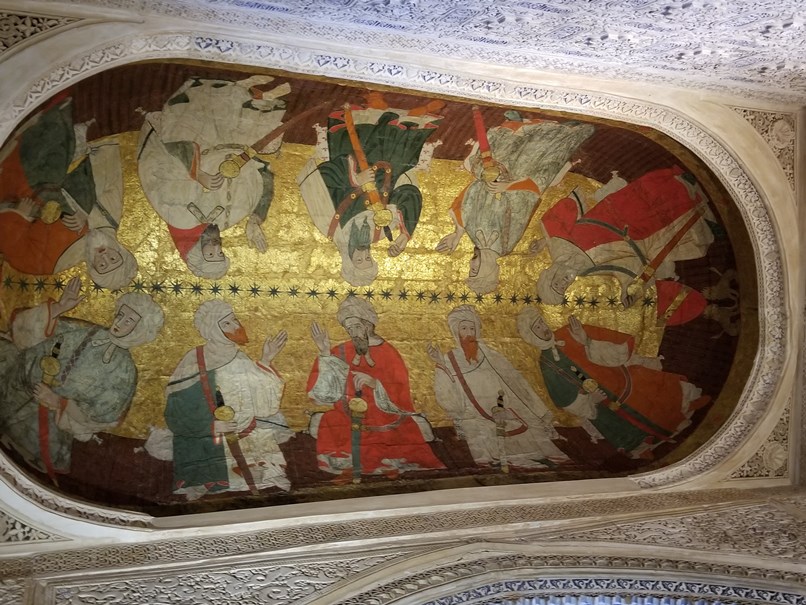
Mirador de Daraxa – connected to the Hall of Two Sisters – has a unique beauty. Here you have all the elaborate decorations that one sees throughout the Palace of the Lions: The mocárabes that resemble honeycomb; the calligraphy; the ataurique – that covers brightly colored ceramic tiles with rhythmic patterns of leaves, fruits, and flowers; and tessellations – designs and patterns that are ingeniously arranged so that there are no spaces between them and they never overlap. Nasrid artisans took this concept further, introducing polygons and wheels and combining them into a harmonious surface. Added to this decorative beauty are the views of the gardens through the wall arches. Box hedges with perfectly crisp edges are arranged among sentinel cypresses, orange trees, and acacias. It’s tranquil and mesmerizing.
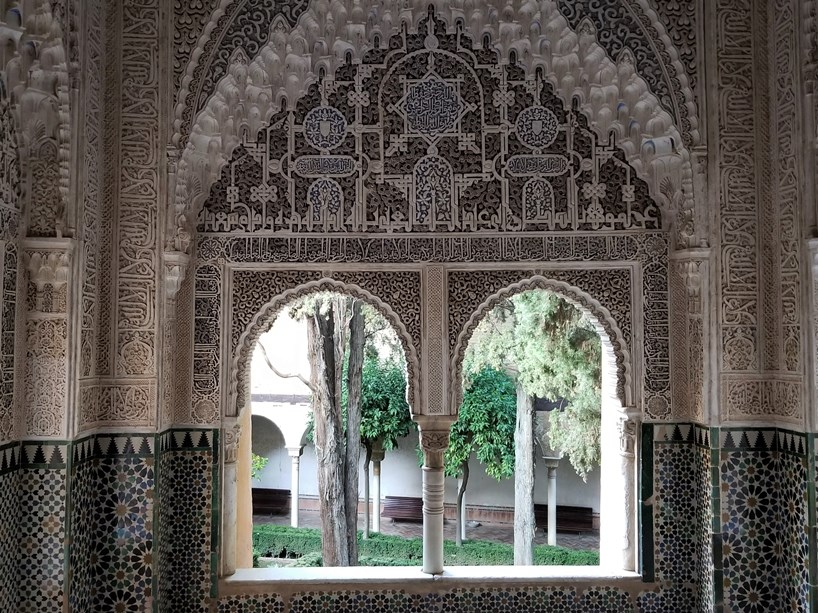
The Palace of Charles V. In 1492, King Ferdinand of Aragon and Queen Isabella of Castile conquered Granada, unified Spain and Islamic rule ended. In 1526, Charles V commissioned a new palace, befitting an emperor, to be built in close proximity to the Nasrid Palaces within the walls of the Alhambra. The architect was Spanish born Pedro Machura, who designed an Italian Renaissance-style building. While the exterior is somewhat austere, the majestic, colonnaded, circular interior courtyard is a magnificent piece of architecture. Today the palace functions as a museum.
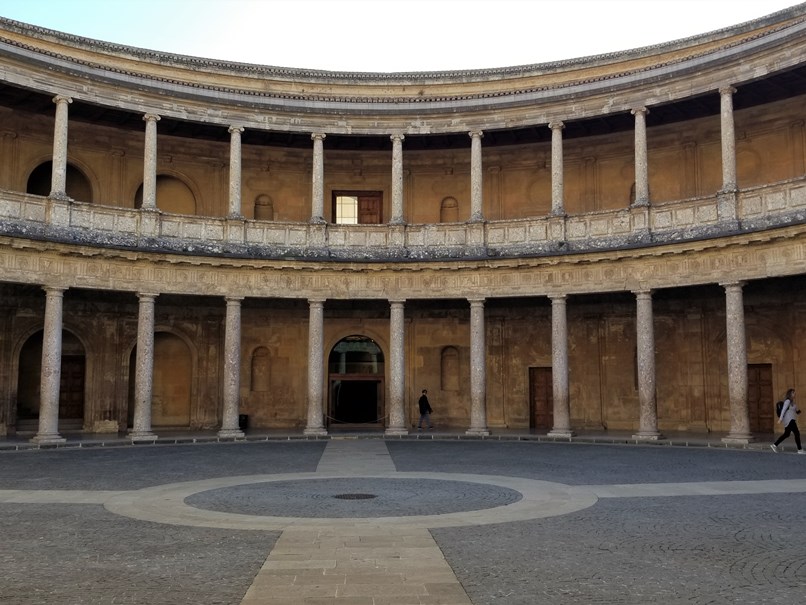
The Alcazaba – means fort or castle. Its purpose was to shelter the sultans from external attacks and house the military staff. It functioned until 1492 when the Moors surrendered Granada to the Spanish Christian kings who took possession of the Alhambra and its opulent palaces. Taking a stroll through the ruins of Alcazaba is worthwhile. Notice the arched wall niches that display the round balls of stone ammunition, then climb the steep winding steps to the top of Candle Tower for commanding views of Grenada and the surrounding hills. In the 16th century, the tower became known as the Sun Gate. The inhabitants of Granada would use the reflection of the sun on the front wall at midday as a sundial.
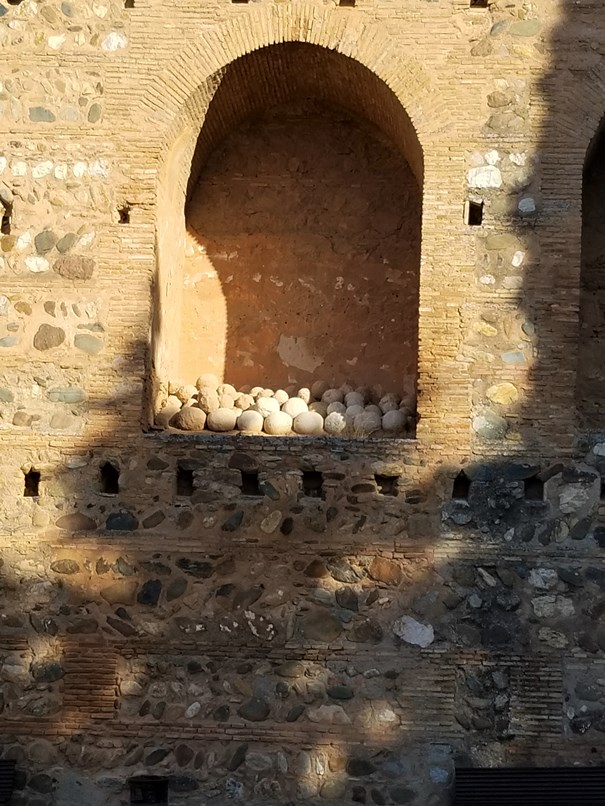
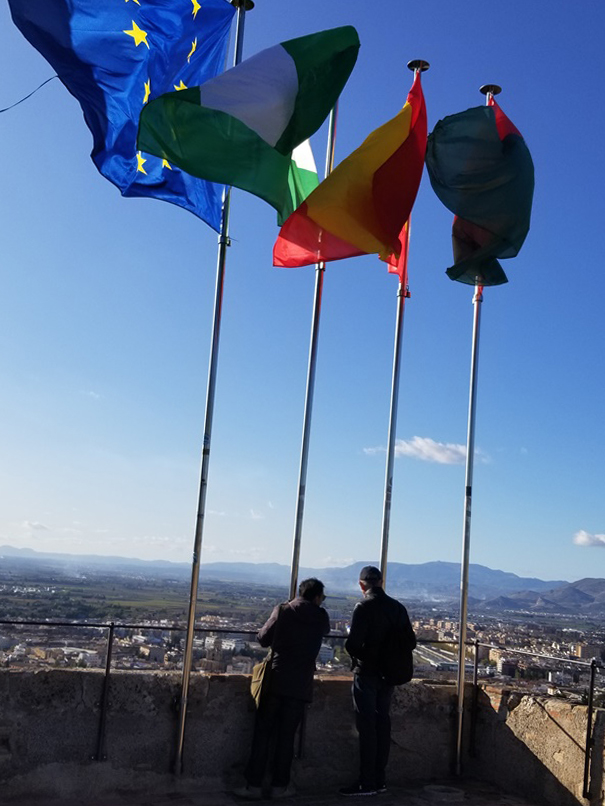
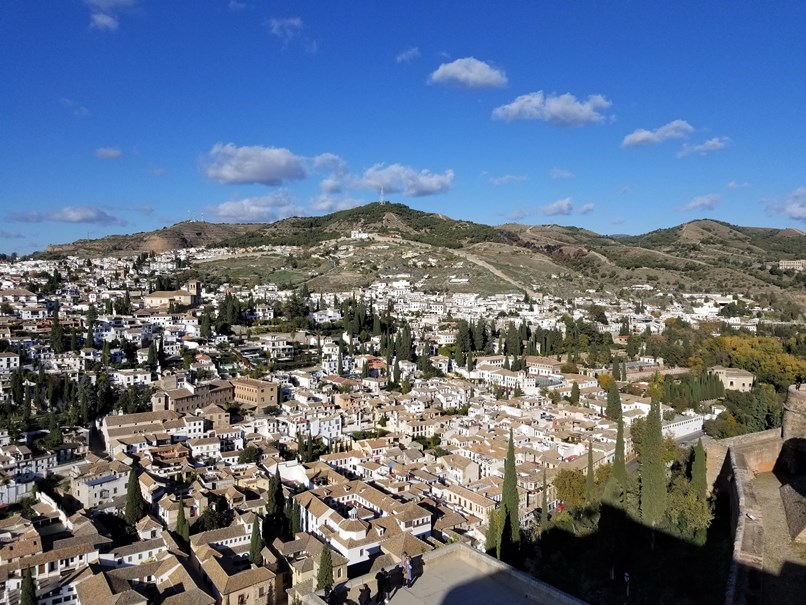
Preparing for your visit to the Alhambra.
1) You must book several months in advance to avoid disappointment.
2) Book online at www.alhambraonline.com
3) Make sure that you book for The Alhambra; the Summer Palace and Generalife Gardens; and the Nasrid Palaces.
4) You will be given a time slot for the Nasrid Palaces. You can explore the Alhambra, the Summer Palace, and Generalife Gardens before or after your time slot for the Nasrid Palaces.
5) Allow 3 ½ to 4 hours in total.
6) There are several tour options:
*Alone with an audio guide
*A Private Tour (I highly recommend this. Their guides are excellent, and it takes the experience to another level.)
*A new option: A tour through 5 senses, where audiovisual support and sensorial stimulus take the visitor into the past and the era of Nasrid splendor.
*There are also night tours and educational tours.
7) One can either reserve a morning or afternoon visit. If you are coming from another town, play it safe and reserve the afternoon tour.
8) Wear comfortable shoes, carry a snack: Crackers, nuts, an energy bar, and water.
9) Make sure that you eat a meal before your tour as the only place to purchase any food is a vending machine next to the restrooms close to Charles V palace that offers snacks, coffee, water, and sodas.
10) Another option is the Parador restaurant inside the walls of the Alhambra in the Parador Hotel. Make reservations in advance. A more convenient option is to park your car in the open-air parking lots, and on your left, before you get to the ticket office and tour meeting location, you’ll see a couple of restaurants. Their food is good, and the prices just as good.
11) NOTE: You must carry your original passport, and the reservation must have the name, surname, and passport number of each visitor.
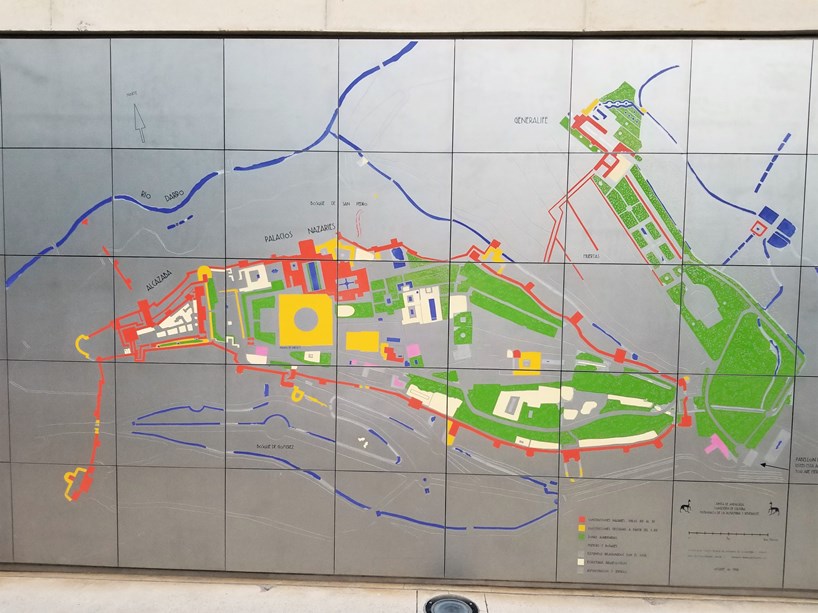
Disclosure: I did not take the photo of the Alhambra at sunset.
